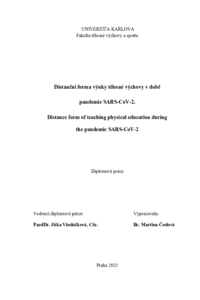Distanční forma výuky tělesné výchovy v době pandemie SARS-CoV-2
Distance form of teaching physical education during the pandemie SARS-CoV-2
diplomová práce (OBHÁJENO)

Zobrazit/
Trvalý odkaz
http://hdl.handle.net/20.500.11956/127413Identifikátory
SIS: 214342
Kolekce
- Kvalifikační práce [8435]
Autor
Vedoucí práce
Oponent práce
Červinka, Pavel
Fakulta / součást
Fakulta tělesné výchovy a sportu
Obor
Učitelství pro střední školy - tělesná výchova - Učitelství geografie pro střední školy
Katedra / ústav / klinika
Atletika
Datum obhajoby
22. 6. 2021
Nakladatel
Univerzita Karlova, Fakulta tělesné výchovy a sportuJazyk
Čeština
Známka
Velmi dobře
Klíčová slova (česky)
SARS-CoV-2, distanční výuka, tělesná výchova, vládní opatření, pandemieKlíčová slova (anglicky)
SARS-CoV-2, distance learning, physical education, government measures, pandemicNázev: Distanční forma výuky tělesné výchovy v době pandemie SARS-CoV-2. Cíle: Cílem této práce bylo zjistit průběh a zajištění výuky tělesné výchovy v době pandemie SARS-CoV-2 od 1. 1. 2020 až do 31. 12. 2020. Metody: Pro napsání práce byl použit online dotazník, který byl přes sociální sítě a prostřednictvím emailu učitelům TV sdílen. Pro sběr dat byla použita metoda CAWI. Data byla následně zpracována pomocí MS Excel 2013. Výsledky: Z výsledků vyplývá, že v jarním období probíhala výuka tělesné výchovy mnohem méně a méně často než v podzimní období. Na jaře učitelé ještě neměli tak technické vybavení oproti podzimu a výuka především probíhala v offline formě. V podzimním období už více učitelů vyučovalo online formou, zaměřovali se zejména k motivaci dětí k pohybu. V jarní části byla výuka více zaměřena teoreticky. Respondenti se shodli, že výpadek ve výuce tělesné výchovy bude mít velký dopad na rozvoj dětí v budoucnosti. Klíčová slova: SARS-CoV-2, distanční výuka, tělesná výchova, vládní opatření, pandemie
Title: Distance form of teaching physical education during the pandemic SARS- CoV-2. Aims: The aim of this work was to determine the course and provision of physical education in the time of the SARS-CoV-2 pandemic from 1 January 2020 to 31 December 2020. Methods: An online questionnaire was used to write the work, which was shared with teachers via social networks and via email. CAWI method was used for data collection. The data were subsequently processed using MS Excel 2013. Results: The results show that in the spring the teaching of physical education took place much less and less often than in the autumn. In the spring, the teachers did not yet have such technical equipment compared to the autumn, and the teaching took place mainly in an offline form. In the autumn, more teachers taught online, focusing mainly on motivating children to move. In the spring part, the teaching was more theoretically focused. Respondents agreed that a failure in physical education will have a major impact on children's development in the future. Keywords: SARS-CoV-2, distance learning, physical education, government measures, pandemic
